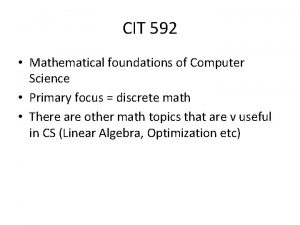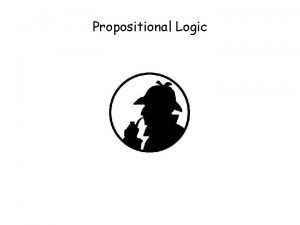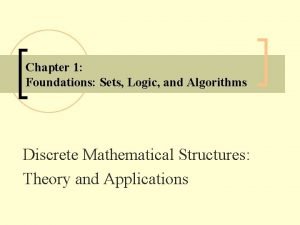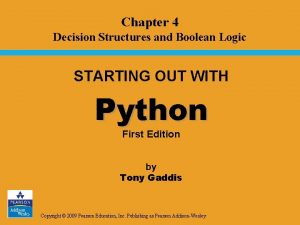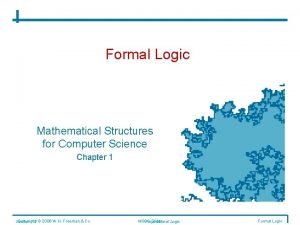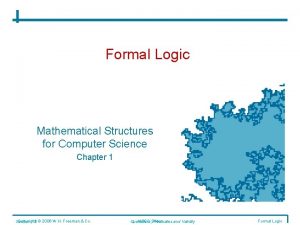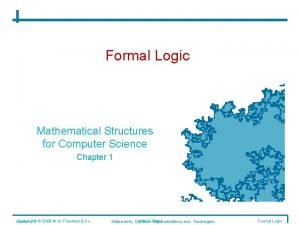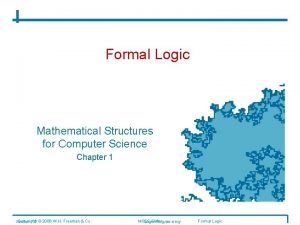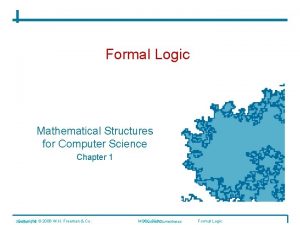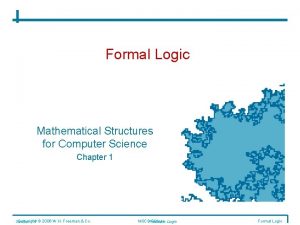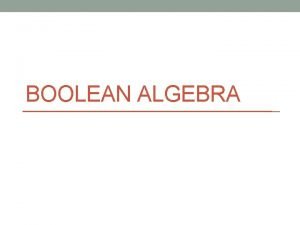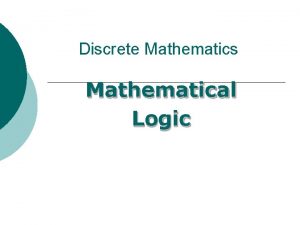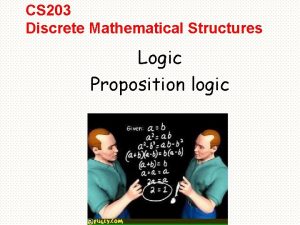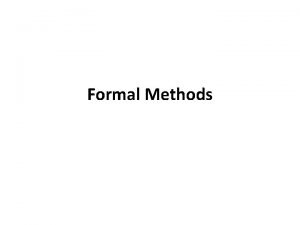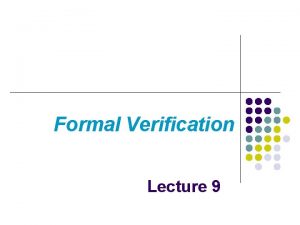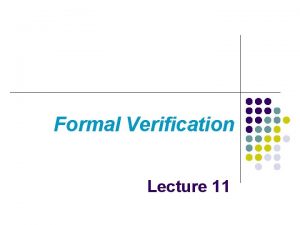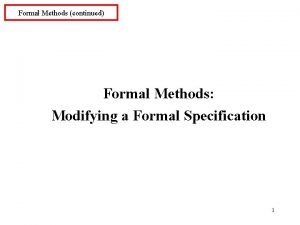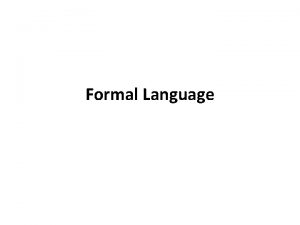Formal Logic Mathematical Structures for Computer Science Chapter


















- Slides: 18

Formal Logic Mathematical Structures for Computer Science Chapter 1 Copyright Section 1. 2 © 2006 W. H. Freeman & Co. MSCS Slides Propositional Logic Formal Logic

Propositional Logic Section 1. 2 Deriving a logical conclusion by combining many propositions and using formal logic: hence, determining the truth of arguments. Definition of Argument: An argument is a sequence of statements in which the conjunction of the initial statements (called the premises/hypotheses) is said to imply the final statement (called the conclusion). An argument can be presented symbolically as (P 1 Λ P 2 Λ. . . Λ Pn) Q where P 1, P 2, . . . , Pn represent the hypotheses and Q represents the conclusion. Propositional Logic 1

Valid Argument What is a valid argument? When does Q logically follow from P 1, P 2, . . . , Pn. Informal answer: Whenever the truth of hypotheses leads to the conclusion Note: We need to focus on the relationship of the conclusion to the hypotheses and not just any knowledge we might have about the conclusion Q. Example: Section 1. 2 P 1: Neil Armstrong was the first human to step on the moon. P 2 : Mars is a red planet And the conclusion Q: No human has ever been to Mars. This wff P 1 Λ P 2 Q is not a tautology Propositional Logic 2

Valid Argument Definition of valid argument: An argument is valid if whenever the hypotheses are all true, the conclusion must also be true. A valid argument is intrinsically true, i. e. (P 1 Λ P 2 Λ. . . Λ Pn) Q is a tautology. How to arrive at a valid argument? Section 1. 2 Using a proof sequence Definition of Proof Sequence: It is a sequence of wffs in which each wff is either a hypothesis or the result of applying one of the formal system’s derivation rules to earlier wffs in the sequence. Propositional Logic 3

Rules for Propositional Logic Section 1. 2 Derivation rules for propositional logic Equivalence Rules Inference Rules Allows individual wffs to be rewritten Allows new wffs to be derived Truth preserving rules Work only in one direction Propositional Logic 4

Equivalence Rules Section 1. 2 These rules state that certain pairs of wffs are equivalent, hence one can be substituted for the other with no change to truth values. The set of equivalence rules are summarized here: Expression Equivalent to Abbreviation for rule RVS SVR Commutative comm (R V S) V Q (R Λ S) Λ Q R Λ (S Λ Q) R V (S V Q) Associativeass (R V S) (R Λ S) R Λ S R V S De-Morgan’s Laws De-Morgan R S R V S implication - imp R (R ) Double Negation- dn P Q (P Q) Λ (Q P) Equivalance - equ Propositional Logic 5

Inference Rules Inference rules allow us to add a wff to the last part of the proof sequence, if one or more wffs that match the first part already exist in the proof sequence. From Can Derive Abbreviation for rule R, R S S Modus Ponens- mp R S, S R Modus Tollens- mt R, S RΛS Conjunction-con RΛS R, S Simplification- sim R RVS Addition- add Note: Inference rules do not work in both directions, unlike equivalence rules. Section 1. 2 Propositional Logic 6

Examples Example for using Equivalence rule in a proof sequence: Simplify (A V B ) V C 1. (A V B ) V C 2. (A Λ B) V C 3. (A Λ B) C 1, De Morgan 2, imp Example of using Inference Rule If it is bright and sunny today, then I will wear my sunglasses. Modus Ponens It is bright and sunny today. Therefore, I will wear my sunglasses. Modus Tollens I will not wear my sunglasses. Therefore, it is not bright and sunny today. Section 1. 2 Propositional Logic 7

Deduction Method To prove an argument of the form P 1 Λ P 2 Λ. . . Λ Pn R Q Deduction method allows for the use of R as an additional hypothesis and thus prove P 1 Λ P 2 Λ. . . Λ Pn Λ R Q Prove (A B) Λ (B C) (A C) Using deduction method, prove (A B) Λ (B C) Λ A C • A B hyp • B C hyp • A hyp • B 1, 3 mp • C 2, 4 mp Section 1. 2 The above is called the rule of Hypothetical Syllogism or hs in short. Many such other rules can be derived from existing rules which thus provide easier and faster proofs. Propositional Logic 8

More Inference Rules Section 1. 2 These rules can be derived using the previous rules. They provide a faster way of proving arguments. From Can Derive Name / Abbreviation P Q, Q R P R Hypothetical syllogismhs P V Q, P Q Disjunctive syllogismds P Q Q P Contraposition- cont Q P P Q Contraposition- cont P PΛP Self-reference - self PVP P Self-reference - self (P Λ Q) R P (Q R) Exportation - exp P, P Q Inconsistency - inc P Λ (Q V R) (P Λ Q) V (P Λ R) Distributive - dist P V (Q Λ R) (P V Q) Λ (P V R) Distributive - dist Propositional Logic 9

Proofs of inference rules Prove that (P Q) (Q P ) is a valid argument (called Contraposition – con). Prove P Λ P Q (called Inconsistency) • • Section 1. 2 Hence prove, (P Q) Λ Q P (using deduction method). The above is true using the modus tollens inference rule. P P PVQ QVP (Q ) V P Q P (Q ) Q hyp 1, add 3, comm 4, dn 5, imp 2, 6, mt 7, dn Propositional Logic 10

Proofs using Propositional Logic Prove the argument A Λ (B C) Λ [(A Λ B) (D V C )] Λ B D First, write down all the hypotheses. • A • B C • (A Λ B) (D V C ) • B Use the inference and equivalence rules to get at the conclusion D. • C 2, 4, mp • AΛB 1, 4, con • D V C 3, 6, mp • C V D 7, comm • C D 8, imp and finally • D 5, 9 imp The idea is to keep focused on the result and sometimes it is very easy to go down a longer path than necessary. Section 1. 2 Propositional Logic 11

More Proofs • • • • Section 1. 2 (A Λ B) Λ (C Λ A) Λ (C Λ B ) A is an argument (A Λ B) (C Λ A) (C Λ B ) A V B B V A B A (C ) V A C V (B ) V C B A (B A ) Λ (B A ) hyp hyp 1, De Morgan 4, comm 5, imp 2, De Morgan 7, imp 3, De Morgan 9, comm 10, imp 8, 11, hs 6, 12, con Propositional Logic 12

Proof Continued At this point, we have now to prove that (B A ) Λ (B A ) A • • • Section 1. 2 Proof sequence B A A B A A A V A A hyp 1, cont 3, 2, hs 4, imp 6, self Propositional Logic 13

Proving Verbal Arguments Russia was a superior power, and either France was not strong or Napoleon made an error. Napoleon did not make an error, but if the army did not fail, then France was strong. Hence the army failed and Russia was a superior power. Converting it to a propositional form using letters A, B, C and D A: Russia was a superior power B: France was strong C: Napoleon made an error D: The army failed Combining, the statements using logic (A Λ (B V C)) C (D B) (D Λ A) B : France was not strong C : Napoleon did not make an error D : The army did not fail hypothesis conclusion Combining them, the propositional form is (A Λ (B V C)) Λ C Λ (D B) (D Λ A) Section 1. 2 Propositional Logic 14

Verbal Argument Proof Section 1. 2 Prove (A Λ (B V C)) Λ C Λ (D B) (D Λ A) Proof sequence 1. A Λ (B V C) 2. C 3. D B 4. A 5. B V C 6. C V B 7. B 8. B (D ) 9. (D ) 10. D 11. D Λ A hyp hyp 1, sim 5, comm 2, 6, ds 3, cont 7, 8, mp 9, dn 4, 10 , con Propositional Logic 15

Class Exercise Prove the following arguments (A´ B´) Λ (A C) (B C) (Y Z´) Λ (X´ Y) Λ [Y (X W)] Λ (Y Z) (Y W) If the program is efficient, it executes quickly. Either the program is efficient, or it has a bug. However, the program does not execute quickly. Therefore it has a bug. (use letters E, Q, B) The crop is good, but there is not enough water. If there is a lot of rain or not a lot of sun, then there is enough water. Therefore the crop is good and there is a lot of sun. (use letters C, W, R, S) Section 1. 2 Propositional Logic 16

Class Exercise Section 1. 2 Write down the propositional form of the following argument: If my client is guilty, then the knife was in the drawer. Either the knife was not in the drawer or Jason Pritchard saw the knife. If the knife was not there on October 10, it follows that Jason Pritchard didn’t see the knife. Furthermore, if the knife was there on October 10, then the knife was in the drawer and also the hammer was in the barn. But we all know that the hammer was not in the barn. Therefore, ladies and gentlemen of the jury, my client is innocent. Propositional Logic 17
 Cit 592
Cit 592 Elements of mathematical economics
Elements of mathematical economics Normal forms in mathematical logic
Normal forms in mathematical logic Not proposition example
Not proposition example Mathematical logic laws
Mathematical logic laws Favourite subject
Favourite subject Give other examples of homologous structures
Give other examples of homologous structures Decision structures and boolean logic
Decision structures and boolean logic Digital logic structures
Digital logic structures First order logic vs propositional logic
First order logic vs propositional logic First order logic vs propositional logic
First order logic vs propositional logic First order logic vs propositional logic
First order logic vs propositional logic Concurrent vs sequential
Concurrent vs sequential Tw
Tw Software project wbs example
Software project wbs example Is it x y or y x
Is it x y or y x Combinational logic sequential logic 차이
Combinational logic sequential logic 차이 Combinational logic sequential logic
Combinational logic sequential logic Mathematical foundations of computer graphics and vision
Mathematical foundations of computer graphics and vision
